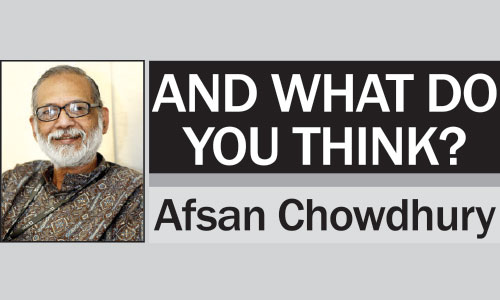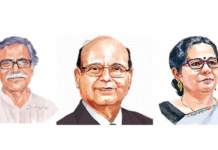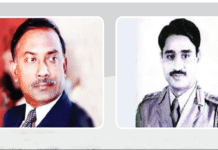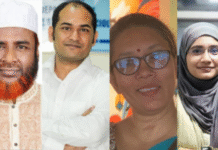ADRAINAGE system nearing collapse, incompetent public service facilities, media outlets hungry for hype and stereotyping and self-proclaimed anti-jangibadi warriors all together led to a large Qurbani controversy centred on Facebook and other media. It began with two unrelated elements.
Several images showing Dhaka streets had turned into ‘rivers of blood’ were carried by a number of Dhaka media outlets. Soon it was picked up by international media, including Indian media, who also added some political and social interpretations to the scene. Meanwhile, many said that the images were Photoshopped and this brought the debate to an even more new and angry level.
This was followed by several people who uploaded gruesome images of themselves and their family members, including of children with their feet and hands dipped in cow blood, posing with slaughtered Qurbani animals, etc. It was horrific and deserves extreme condemnation. It also led to a group trashing Islam as practised by Bangladeshi Muslims around Qurbani. The group said Qurbani is an expression of ‘natural cruelty’ of Muslims and then went on to link it with the Gulshan café attack, including showing all the images including jangis in a single collage image which was published on Facebook.
Apart from offending many Muslims who saw the images and the twisting of Islam into terrorism as an insult of their faith practices, it also rallied many Islamic extremists who have portrayed Sheikh Hasina and her government as a ‘threat to Islam’. They immediately ramped home their own stereotype with the AL government and India being in the same league with the same objective. The incident showed how deeply troubling the times are in which we live as the enemies of moderation are obviously active on both sides.
***
THE posting of pictures on Facebook with people posing with slaughtered animals is extremely disgusting, not just because it shows cruelty of posing with blood and gore but by turning a religious act of sacrifice — at least going on the face of it — into a form of conspicuous consumption and trophy display. Many people asked how such pictures could be posted on Facebook and the cultural level of such poster’s but the point is when the objective of many is to show off wealth, this is only to be expected. Clearly, in today’s Bangladesh the objective of faith practices is not to celebrate the divine but the credit card and the cash.
***
BUT if those people decided to make asses of themselves and post it on Facebook, then the actions of some ‘anti-Qurbani’ elements may potentially lead to social discord. What several of them did was to take screenshots of the ‘qurbani’ ghoulish scenes and then say that this was being done by accomplices of al-Badrs and also that it is this type of cruelty that leads to the attack of the Holey Artisan Café. In other words, all participants in the Qurbani were demonised and through association called al-Badr. They had also become accessories to the Gulshan attack.
This group sees themselves as the vanguard force against the jangis and its leader was described by an admiring supporter as equivalent to Nazrul Islam and Begum Rokeya rolled into one. This does sound silly since very few have even heard of him. One would have thought that the Ghatak Dalal Nirmul Committee, Ganajagaran Mancha and the many people from Jahanara imam to Imran Sarker had better credentials at that in fighting Bangladeshi jangis. This is not to mention Sheikh Hasina at all but such people have the potential to cause damage to the balancing act that Sheikh Hasina has been trying to do on the issue of religious practices and fighting religious extremists.
***
THE rivers-of-blood pictures published in media outlets showing Dhaka streets flowing red were immediately picked up by international media, including Indian media. Bangladesh was portrayed as a sort of ‘blood thirsty’ which reinforced the stereotype of the ‘Muslim’ as the cruel terrorist.
But the matter did not end there as several Bangladeshis then suggested the pictures were Photoshopped to show the blood red on the street. One Bangladeshi, Pinaki Bhattacharya, who had tried to show that a particular image was Photoshopped was immediately dubbed either as a hero or a Razakar, depending on which side of the debate the person was. Indians took the Photoshop accusations hard and Zee News even ran a special on the accusation saying that it was an authentic scene. Soon, it became a matter of Indo-Bangla tension at the public space level which always as expected has a communal angle.
***
SEVERAL factors, therefore, came together to create a situation but everyone, including international media, lacked moderation and is responsible for this. India clearly has a cow card to play and so denigrating Qurbani will happen and more so in the future to play its local politics. But the story was about a bad drainage system which had nothing to do with the blood thirst of Muslims. It was about an inefficient municipal system. Thus, rains flooded the streets, pictures were taken well — some say a red tint was applied — and, of course, the stereotype and political purpose were well served.
While some talked on a better management of such waste, most voices were emotional and some were downright offensive to Bangladeshi Muslims and their practices. Those who took upon themselves to put Qurbani and Islam and terrorism and the Gulshan attack on the same plate managed to ignite Facebook tension and create a possible backlash beyond it. Global media and Indian media had their agenda and have served it well but in Bangladesh, a stream of resentment has been cranked up.
***
QURBANI has always been a rancorous celebration in South Asia and Bengal with both Hindu and Muslim communities often bringing out their worst in such times. Thus inter-communal peace-keeping has always been a major issue in times of Qurbani. Even the fabled Bengal Pact of 1924 drafted by Chittaranjan Das, who was the greatest champion of inter-communal harmony, had prescribed how such ritual slaughtering and music playing at prayer times be managed peacefully. But Qurbani came this year in Bangladesh with considerable potential for future hazards, exposing the social fissures that exist and cannot be denied with so many players holding so many political agenda cards.
In the end, we have proved we are our own worst enemy. Political objectives seem to play a bigger role than social and inter-communal harmony. It also shows how advantages can be taken of situations no matter how cautious one is.
Afsan Chowdhury is journalist and researcher.
Source: New Age











Well written, well-argued. Also exposes the dark sides of social media. There are fundamentalists on both sides – secularists and religionists (of all denominations). A statesman is one who can rise above narrow immediate political aims and Chittaranjan Das was one of the few statesmen that we had. Unfortunately, Statesmen are rare not just in Bangladesh, but in the whole world. We can only see one at the international arena – Angenla Markel of Germany.